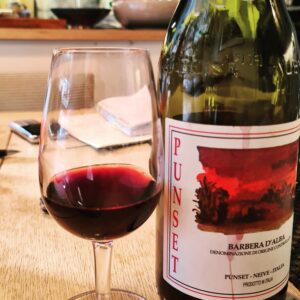norman.comfort@getcomfortable.co.uk, or talk to me on 07530 708125. Let's do this.....
The Punset Winery – Featuring Arneis & Barbera
These two Italian wines come from the Punset Winery in Neive, a beautiful village in the Cuneo area of Piedmont. Punset is a family owned vineyard, which was founded in 1964 by Renzo Marcarino. In the early days the family had an intuitive desire to grow grapes as naturally as possible, but it is the daughter, Marina who pushed the vineyards towards fully organic grape growing and is the wine maker today. Not content with this, the winery is now effectively biodynamic. Family, nature, and natural wine making are at the heart of this family’s philosophy and their wines.
These guys make a range of wines from classic grape varieties found in Piedmont, but I am going to focus on two, Arneis and Barbera.
Punset Arneis Langhe DOC – 2020
 Arneis a grape that was almost extinct by the early 1960’s, but now is enjoying a comeback. Low-yielding and susceptible to powdery mildew in warm seasons it needs careful management in the vineyard. It can struggle to retain it’s acidity, so picking at the right moment is essential. In return for this effort, Arneis can make a beautiful wine and this is a great example. This Arneis comes from grapes grown in the Langhe region of Piedmont. Langhe is a hilly area to the south and east of the river Tanaro in the provinces of Cuneo and Asti in Piedmont, Northern Italy. The aspect and altitude combine to provide great diurnal temperature ranges with long days of sunshine and cooler nights refreshing the grapes acidity and lengthening the growing season. Perfect location for Arneis to thrive.
Arneis a grape that was almost extinct by the early 1960’s, but now is enjoying a comeback. Low-yielding and susceptible to powdery mildew in warm seasons it needs careful management in the vineyard. It can struggle to retain it’s acidity, so picking at the right moment is essential. In return for this effort, Arneis can make a beautiful wine and this is a great example. This Arneis comes from grapes grown in the Langhe region of Piedmont. Langhe is a hilly area to the south and east of the river Tanaro in the provinces of Cuneo and Asti in Piedmont, Northern Italy. The aspect and altitude combine to provide great diurnal temperature ranges with long days of sunshine and cooler nights refreshing the grapes acidity and lengthening the growing season. Perfect location for Arneis to thrive.
Note that this wine is DOC and not DOCG, suggesting that the winery has not pushed for the “garantita,” or guarantee status of this wine, which requires approval from an independent tasting panel and comes with the associated costs.
On the eye: pale lemon
On the nose: pronounced, we find blossom, bruised apple, pear, grape, apricot, nectarine, melon, passion fruit, fennel, dill, dried herbs, white pepper, wet stone, yogurt and almond.
On the pallet: dry with medium acidity, medium plus alcohol, a full body with pronounced flavours as found on the nose. The wine has a long finish.
This wine is outstanding in quality. The aromas found on the nose are intriguing and complex. The wine has a delightful balance between acidity which is refreshing yet understated and the alcohol which despite being medium plus is barely noticeable. The wine has a lovely mouth texture and intensity which is enhanced by the lees aging. As with the nose, on the pallet the wine has a real complexity with every flavour being well defined and spanning many clusters from green, citrus, and stone fruits, to secondary and tertiary characteristics such as yogurt and almonds. As you might expect this wine has a delightful finish which is long and evolving allowing the drinker time to savour every sip!
So what are the wine making techniques that make this wine so outstanding?
– Hand harvested grapes, picked early in the morning when the temperature is still cool, placed in small perforated crates. This ensures only the best grape bunches are picked from the vines. Picking in the morning and transporting in small crates minimises damage to the grapes in transit. This harvesting method ensures only optimum grapes come into the winery and are used to make the wine. Any spoilage from damaged grapes or grapes that are under ripe is avoided.
– 50% of the grapes are gently pressed with the stems still intact to provide pure aromatic fruit flavours and avoid harsher flavours from the skins of the grapes. This happens because the juice runs through channels created by the stems and not over the skins of other crushed grapes. The remaining 50% of the grapes are destemmed and given several days in cold soak to build phenolic flavours. The balance between destemmed and stemmed is a conscious decision by the wine maker to make a precise style of wine.
– Indigenous yeasts are used to provide a unique expression of terroir and flavour to the wine. Many of the flavours in wine come from the fermentation process itself. Using indigenous yeasts imparts unique flavour characteristics to the wine.
– Fermentation is at a cool temperature of 18 – 19 degrees Celsius and is slow, imparting more flavours and complexity to the wine. At cooler temperatures, yeast works at a slower pace which in terms builds more complexity and diversity of flavours.
– The wine is left on the lees for eight months. Lees aging (dead yeast cells left in the wine for a period of time typically six months to one year) adds complex secondary aromas to the wine and also adds body and texture.
Barbera d’Alba is perhaps overshadowed by its neighbours Barolo and Barbaresco, but it makes delicious wines which are sometimes less intense and show more red fruit, particularly cherry for example, on the pallet. The best Barbera d’Alba wines come from grapes grown on hillside vineyard sites close to Barolo
On the eye: medium ruby
On the nose: pronounced, we find rose, violet, redcurrant, raspberry, red cherry, dark plum, blackcurrant, blackberry, blueberry, fennel, dill, dried herbs, white pepper, liquorice, mushroom and wet leaves.
On the pallet: dry with high acidity, high plus alcohol, medium tannins that are ripe and chalky, a full body with pronounced flavours as found on the nose. The wine is intense and has a long finish.
This wine is outstanding in quality. The aromas found on the nose are delightful and complex. The wine has beautiful balance between acidity which is refreshing against the alcohol (despite being high and 14.5% it is barely noticeable) and tannins which are wonderfully well integrated and add to the wine’s body and depth of character. As with the nose, on the pallet the wine has a real complexity with every flavour being well defined and spanning many clusters from red, dark fruits to herbs and spices. Tertiary notes of mushroom and wet leaves tease us with the potential of this wine. As you might expect this wine has a delightful finish which pulls the red and black fruit flavours apart allowing the drinker time to enjoy every aspect of this wine!
So what are the wine making techniques that make this wine so outstanding?
– Harvesting is left until the last moment to give the grapes maximum time to reach phenolic ripeness. This gives the wine the amazing acidity and flavour intensity balance with alcohol at 14%
– Again, hand harvested grapes, picked early in the morning when the temperature is still cool and placed in small perforated crates. This ensures only the best grape bunches are picked from the vines.
– The grapes have the stems removed to give a purity of fruit flavour to the wine and avoid unwanted flavours from the stems which can be harsh or tannic. This approach gives the wine it’s light and approachable tannin structure.
– Again, indigenous yeasts are used to provide a unique set of flavours that help to express the terroir and flavour to the wine. Many of the flavours in wine come from the fermentation process itself. Using indigenous yeasts imparts unique flavour characteristics to the wine.
– Racking is done regularly to give the fruit a purity and maintain a light body.
– Concrete vats are used for aging. Concrete is a neutral storage vessel in terms of flavour, unlike oak, which imparts characteristics such as vanilla, cloves and coconut. However, unlike stainless steel, concrete allows for micro-oxygenation and this encourages the development of the tertiary flavours you can pick up in this wine, adding complexity whilst retailing the elegant freshness of the wine.

